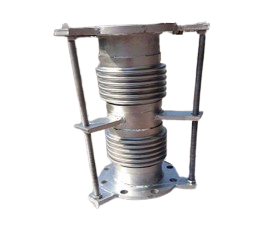Beijing Hownew Energy Technology Group Co., Ltd |
|
Verified Suppliers
|
|
1. Expansion joints(compensators)
Expansion joints, also known as compensators, are integral components made up of bellows (elastic elements) and additional features like end connectors, supports, flanges, and conduits. These flexible structures are installed in vessel shells or pipelines to manage the stresses induced by temperature fluctuations and mechanical vibrations. Through the effective expansion and contraction of the bellows, these joints adeptly accommodate dimensional changes in pipelines, conduits, and vessels, which occur due to thermal dynamics or mechanical displacements, whether axial, lateral, or angular.
Additionally, expansion joints serve critical roles in noise and vibration dampening, as well as in heating supply systems. They are crucial in preventing deformation or damage to heating pipelines that experience thermal expansion and temperature-induced stress, thereby mitigating stress on pipeline walls and reducing force on valves and support structures.
Given their capacity for free expansion and contraction, expansion joints are lauded for their reliable operation, robust performance, and compact design. This makes them indispensable in industries such as chemical engineering, metallurgy, and nuclear energy. Various designs are utilized, with U-shaped, Ω-shaped, and C-shaped being common for vessels. Pipeline-specific joints are categorized by their structural compensation capabilities into universal, pressure balanced, hinged, and gimbal expansion joints, each tailored for specific operational demands.
| Main Item | Classification | Description |
Metal Expansion Joint | ElbowExpansion Joint | U-shaped expansion joints, also known as tension bends, exploit the elastic deformation capacity of pipes to provide compensation in various systems. These joints are celebrated for their robust strength, extended service life, and the convenience of being producible on-site. Despite their benefits, they have notable disadvantages, including their substantial spatial requirements, high consumption of steel, and considerable friction resistance. Due to these characteristics, U-shaped expansion joints are extensively utilized in steam piping systems and other long pipe applications where durability and adaptability are critical. |
Bellows Expansion Joint
| Bellows expansion joints consist of metal bellows that enable axial expansion and contraction, as well as minor bending, of the pipeline. To prevent exceeding designed compensation limits, protective rods or rings and guide supports are installed at both ends. These joints also include angular and lateral types to accommodate rotational and side-to-side movements. Key advantages of bellows expansion joints include their compact design, material efficiency, ease of standardization, and suitability for mass production. However, they tend to have a shorter lifespan compared to other types. Primarily used in low-pressure, low-temperature, short pipeline applications, the scope of bellows expansion joints is growing due to advancements in production technology, now capable of handling systems with pressures up to 6.0 MPa. | |
Slip-Type Expansion Joint | Slip-type expansion joints feature inner and outer sleeves that allow axial movement relative to each other, sealed by a stuffing box to maintain alignment. These joints, comprising sleeves, shells, and advanced sealing materials, are designed to compensate for both axial expansion and rotational movements of pipelines. They are particularly effective in applications involving hot water, steam, and grease, offering substantial compensation in a compact design. The dynamic sealing capability is enhanced by a high-performance, self-sealing system that allows the inner sleeve to slide freely within the outer shell during pipeline expansion or contraction. The use of innovative synthetic materials for seals between the sleeves enhances the joint's resistance to high temperatures, corrosion, and aging, making it suitable for temperatures ranging from -40 to 150 degrees Celsius, and up to 350 degrees Celsius in special cases. This design ensures reliable axial movement and prevents leakage. | |
Non-metallic Expansion Joint | Rubber Expansion Joint | These expansion joints are made from a combination of rubber, rubber-fiber composite materials, steel flanges, sleeves, and insulation materials. They are primarily used to create flexible connections between different fans and ducts. Key functionalities include shock absorption, noise reduction, effective sealing, resistance to various media, and ease of displacement and installation. They serve as essential components for enhancing environmental protection by reducing noise, absorbing shocks, and aiding in the removal of smoke and dust. |
Fabric Expansion Joint | Fabric expansion joints are constructed from fiber fabric, rubber, and other materials capable of withstanding high temperatures. These joints are designed to compensate for the vibration and deformation of fans and ducts. They are versatile in their functionality, allowing for axial, lateral, and angular compensation, and feature no thrust, which simplifies support structures. Additionally, they are corrosion-resistant, can endure high temperatures, and effectively reduce noise and vibrations. Their suitability for hot blast pipes and smoke and dust pipelines in power plants makes them ideal for such applications. The non-metallic nature of the fiber fabric and insulation cotton also contributes to sound absorption and vibration isolation, helping to minimize noise and vibration in boilers, fans, and other systems. Their design is simple and lightweight, facilitating easy maintenance. |
Super Austenitic Stainless Steel:254SMO,904L,AL6XN
Duplex Stainless Steel :2205 Dual phase steel (S31803)
Nickel Based Alloy Steel:INCOLOY800/800H/800HT/840/825,INCONEL600/601/690/625/X-750
Hastelloy Alloy C-276/C-22/X,MONEL400/K500
Pure Nickel:N4,N6(Ni200,Ni201)
Titanium Plate For Stamping:GR1,GR2,TA1,TA2
Austenitic Stainless Steel:SUS304,SUS304L,SUS316,SUS316L,SUS310S,SUS321,SUS316Ti
2. Metal Expansion joints(compensators)








